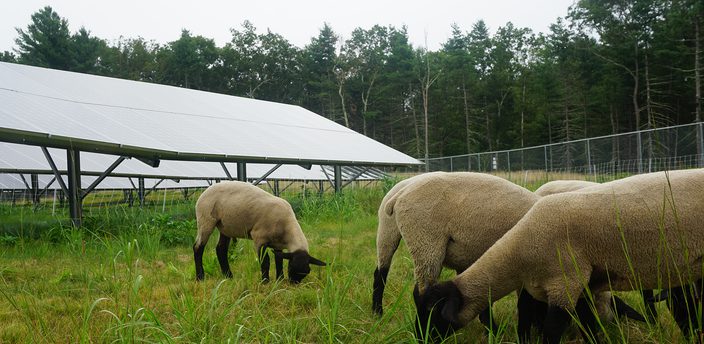Community solar is hot. According to a report from Green Tech Media Research (available here), the community solar market has seen a 5-year annual compound growth rate of 53%, more than twice the rate of the rest of the solar industry (26%). Pretty impressive given the recent growth of the solar industry as a whole: in Q2 alone, 2.1GW of solar PV capacity was added to the grid—enough solar to power 13.1 million U.S. homes.
This rise in community solar makes sense given the aggressive climate goals that many state legislators, businesses, and utilities are making in efforts to reduce carbon emissions. Those commitments, along with solar incentives and the fact that only 57% of U.S. homes are eligible for rooftop solar have made community solar an incredibly exciting renewable energy opportunity.

BlueWave's booth at the 2018 Community Solar 2.0 Conference in New Orleans
Despite the excitement though, community solar can be a difficult product to sell. Why is that? One reason is that community solar programs present many challenges when it comes to messaging. Even with so much interest in solar—89% of adults favor expanding the use of solar—converting that interest into actual purchasing decisions has long been a challenge for many in the industry.
Nonetheless, community solar continues to grow, in part because of the hard work of policymakers and community solar providers around the country who are dedicated to doing what they can to make renewable energy accessible. In my conversations with utility managers, developers, asset owners, and lawyers we often talk through the challenges of community solar marketing and identify some ways to approach those challenges. Throughout these conversations, the same four themes keep coming up and I wanted to share some of our thoughts surrounding those topics.
1. Messaging effectively to different audiences
Like most marketing strategies, it all starts with your audience. However, one of the challenges with community solar is that there are many target audiences. For example, community solar programs and policies vary from state to state, as do customer personas, and therefore different markets and programs often require unique messaging.
To make sure we’re reaching our audiences, we need to do extensive research. What are our customers’ motivations and interests? How do they make decisions? What (and who) influences them? You have to understand the psychological drivers of the decision-makers and those drivers can often vary depending on the person, business, industry, and location. With thorough research and granular audience segmentation, it’s easier to develop messaging and marketing tactics that will resonate with each group.
That being said, one thing remains common among our audiences: residents, small business owners, and C&I managers all want to save money. No matter if they’re motivated by cultural, altruistic, or business drivers, saving money is always attractive.

Ribbon cutting event at a solar project in Wareham, MA constructed by BlueWave
2. Using the right channels and messaging to build trust
Influencing behavior is not an easy thing to do, and you need to use the proper channels to deliver messages that will move your customers. Some will prefer texts from a service provider while others will be confused and even annoyed by the intrusion. Some will want to hear about the environment, and some will only want to hear about savings. Give the wrong message or use the wrong channel and you might deter a decision-maker. Tackling this challenge again requires research. It’s worth spending the time and money to understand your market. If the research is comprehensive, then messaging can be more efficient and fewer interactions will be necessary during customer acquisition because each touchpoint with your potential customers will be more targeted, more effective, and more likely to convert. Doing the work to understand your customers will also help to build their trust in you as their community solar provider. Community solar is still a relatively new and confusing product which means that customer trust is an essential piece of the sales puzzle. At the end of the day, the customer needs to feel comfortable and trust that their provider will educate them accurately, support them when necessary, and address their needs. One way to build this trust is to do the work required to be genuine, transparent, and direct with your messaging.
3. Balancing the legal constraints & complication of community solar with providing a delightful purchase experience
Consumer products put significant effort into creating a magical customer experience. Whether it’s the glamorous packaging and brand profile of a new phone or the seamless, customized experience of Amazon or Lyft, a simple, consumer-oriented design is what, in many cases, creates mass-market adoption of a product.
So how can we replicate that process for community solar customers? How do we create that simple, seamless process for customers that makes it easy for them to engage? Well, that turns out to be a pretty big nut to crack because much of the innovation needed to simplify billing and contract terms are constrained by state policies. That’s where trade associations like the Coalition for Community Solar Access come in, lobbying for the structures needed to make community solar programs accessible to more people.
“Community solar is inherently complex, but wherever possible we must do all we can to simplify the customer experience."
Community solar is inherently complex, but wherever possible we must do all we can to simplify the customer experience. That means reducing the complexity of billing, making contracts with simple and clear language, and ensuring there are no termination fees. At the same time, complying with all consumer protection laws is absolutely crucial and requires constant vigilance, and can sometimes, paradoxically, make communications more complicated. As we work toward a simpler community solar product, we must also continuously improve the educational resources that we make available to customers to improve education and adoption of a more complicated product
4. What about low-income customers?
On its surface, community solar for low and moderate-income (LMI) customers seems like a no-brainer. LMI customers spend a large percentage of their earnings on their utility bills, which means that community solar offers a real savings opportunity for them with no upfront financial investment. At the same time, for community solar providers, it’s an opportunity to access a previously untapped segment of potential customers. A win-win, right? Well it’s not always that easy, but progress is being made and BlueWave and others are starting to bridge the gap between LMI customers and financers by designing improved products and terms that appeal more to this target audience.
One thing is for sure: it benefits all of us to bring more community solar subscribers on board because those subscribers are who make our projects possible. Not to mention, more solar means less fossil fuel, which is why we got into this business in the first place.
Safiyyah Khan discusses best practices in marketing community solar
The Bottom Line:
As a long-time developer of community solar projects, BlueWave has certainly experienced our share of challenges. But for every challenge we faced, we learned important lessons along the way. Our hard-won experience informs the way that we now provide customer acquisition and management services to other developers and asset owners. We segment carefully and engage prospects (and then customers) with regular touchpoints from day one. We try to keep their experience as simple as possible, and we actively seek out new ways to give as many people access to solar as we can, bringing us closer to our vision of protecting the planet by transforming access to renewable energy.
---
BlueWave Blueprints is a video series exploring the ever-expanding world of community solar. In each episode we sit down with different BlueWave experts to discuss various aspects of community solar, from customer engagement and billing to utility coordination and credit management. Each episode offers unique insights, building towards a better understanding of the important role of community solar service providers.


